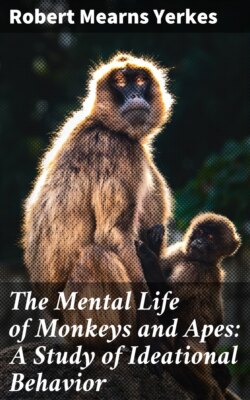Читать книгу The Mental Life of Monkeys and Apes: A Study of Ideational Behavior - Robert Mearns Yerkes - Страница 5
EXPLANATION OF PLATE II
ОглавлениеFIGURE 3.—Orang utan, Julius, reaching for banana.
FIGURE 4.—Julius walking across his cage.
FIGURE 5.—P. rhesus, Sobke.
FIGURE 6.—Sobke stretching his jaws (yawn?) preparatory to a fight.
FIGURE 7.—P. irus, Skirrl.
FIGURE 8.—Skirrl using hammer and nail.
FIGURE 9.—Skirrl using a saw.
All of the animals except the orang utan had been used more or less for experiments on behavior by Doctor Hamilton, but this prior work in no way interfered with my own investigation. Doctor Hamilton has accumulated a large mass of the most valuable and interesting observations on the behavior of monkeys, and he more thoroughly understands them than any other observer of whom I have knowledge. Much to my regret and embarrassment in connection with the present report, he has thus far published only a small portion of his data (Hamilton, 1911, 1914). In his most recent paper on "A study of sexual tendencies in monkeys and baboons," he has given important information concerning several of the monkeys which I have observed. For the convenience of readers who may make use of both his reports and mine, I am designating the animals by the names previously given them by Hamilton. The available and essential information concerning the individuals is presented below.
List of animals in collection
Skirrl. Pithecus irus. Adult male.
Sobke. P. rhesus. Young adult male.
Gertie. P. irus-rhesus. Female. Born November, 1910.
Maud. P. rhesus. Young adult female.
Jimmy II. P. irus. Adult male.
Scotty. P. irus (?). Adult male.
Tiny. P. irus-rhesus. Female. Born August, 1913.
Chatters. P. irus. Adult eunuch.
Daddy. P. irus. Adult eunuch.
Mutt. P. irus. Young adult male. Born August, 1911.
Julius. Pongo pygmaeus. Male. Age, 4 years to 5 years.
When I arrived in Santa Barbara, Doctor Hamilton was about to remodel, or rather reconstruct, his animal cages and laboratory. This gave us opportunity to adapt both to the special needs of my experiments. The laboratory was finally located and built in a grove of live oaks. From the front it is well shown by figure 10 of plate III, and from the rear, by figure 11. Its location was in every way satisfactory for my work, and in addition, the spot proved a delightful one in which to spend one's time.
[Illustration: FIGURE 12.—Ground plan of Montecito laboratory and cages. Scale 1/120
L, laboratory; C, cages; A, experiment room in which multiple-choice apparatus was installed; B, E, additional rooms for research; D, store room and shop; Z, large central cage communicating with the eight smaller cages 1–8.]
Figure 12 is a ground plan, drawn to scale, of the laboratory and the adjoining cages, showing the relations of the several rooms of the laboratory among themselves and to the nine cages. Although the construction was throughout simple, everything was convenient and so planned as to expedite my experimental work. The large room A, adjoining the cages, was used exclusively for an experimental study of ideational behavior by means of my recently devised multiple-choice method. Additional, and supplementary, experiments were conducted in the large cage Z. Room D served as a store-room and work-shop.
The laboratory was forty feet long, twenty-two feet wide, and ten feet to the plate. Each small cage was six, by six, by twelve feet deep, while the large compartment into which each of the smaller cages opened was twenty-four feet long, ten feet wide, and twelve feet deep.
